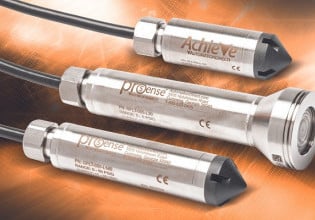Compact, Multicolor Capability: Leuze Delivers Its Smallest Contrast Sensor Yet
Leuze is now offering its smallest contrast sensor yet—the KRT 3C. Designed for use in the packaging, the KRT 3C features a compact design, multicolor functionality, and easy setup with its IO-Link interface.
Leuze’s new KRT 3C provides a lot of optical sensing capability in a compact package. Measuring only 17 mm x 32 mm x 17 mm, the KRT 3C will fit in tight spaces, enabling implementation in many automation applications. The KRT 3C has been specifically designed for use in packaging applications, where both the product being packaged and the packaging material needs to be monitored.

Leuze’s new KRT 3C contrast sensor designed for use in packaging applications. Image used courtesy of Leuze
KRT 3C Contrast Sensor
Besides the compact size, the KRT 3C is capable of measuring different wavelengths (colors) from reflective or matte surfaces. Inside the KRT 3C are several passive sensors for detecting white, red, green, and blue light, as well as an active red laser that can be used to provide a constant light source. Overall, this combination of sensors is exceptional at detecting small variations in contrast. This can help determine where packaging material needs to be cut or verify that the cut has taken place and find stringer defects in plastic and other such operations.
The red, green, and blue light detectors can not only determine defects in a packaging process but also look for color variations where the red, green, and blue (RGB) levels or contrast are out of specification.
The sensor itself connects easily to other industrial automation equipment over an IO-Link interface used by numerous other products. It can respond in as little as 50 microseconds (an embedded laser is capable of pulsing every 125 microseconds).

The KRT 3C being used in a label inspection operation. Image used courtesy of Leuze
Label Inspection Application
Labels used in packaging operations are inspected before use. In the past, this involved moving the uncut labels over a strobe light that flashed at the same rate as the labels passed. An operator would stare down at the labels and look for anomalies. A good operator may have been able to process a few hundred labels a minute, as any deviation from the still image of the perfect label was a defect. Once a defect was detected, the operator would throw a flag on the label film, which would be some distance from the actual defect, based on the operator’s reaction time.
In more recent years, the boring and repetitive job of staring at a strobe light for 8, 10, or 12-hour shifts has been largely replaced by automation. The KRT 3C sensor was designed for this operation. It can measure the returned (reflected) light from the labels and can be used to find defects much more quickly, increasing the throughput of labels and the decreasing length of label film between the defect and the flag.

The KRT 3C being used in tube alignment. Image used courtesy of Leuze
A Compact Advantage
Leuze's KRT 3C sensors' ruggedness and compact size make them an attractive alternative in many automation applications. Multiple wavelengths can be measured, a major advantage over single-wavelength sensors. They also offer an advantage over wideband sensors or cameras that cannot show the contrast as clearly as scanning for several specific wavelengths.





